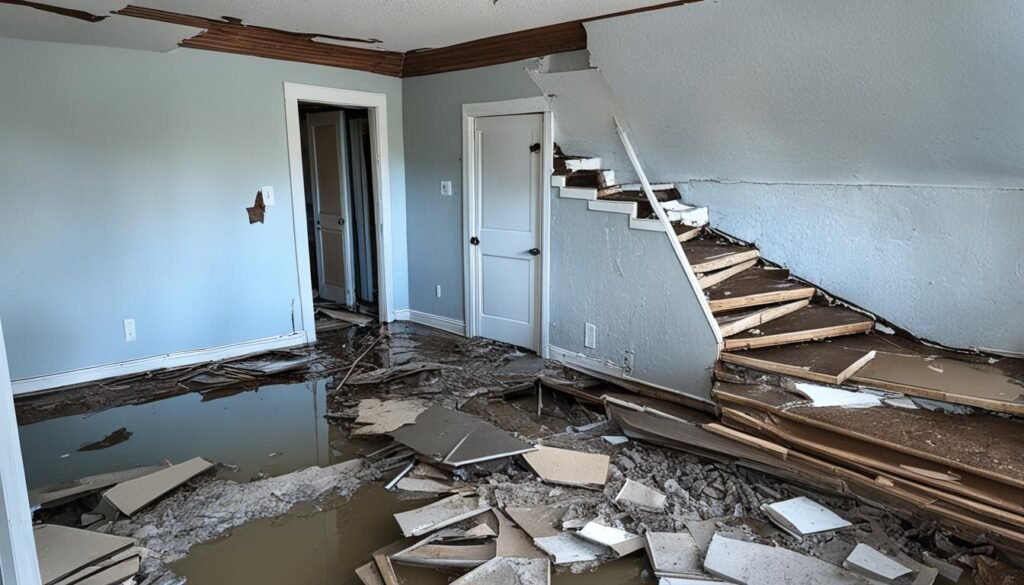Flooding is the top natural disaster in the United States, reaching millions every year. It leaves homes open to many dangers. Taking steps to secure your home and loved ones is key after a flood.
To keep your home safe after a flood, follow these steps:
Key Takeaways:
- Thoroughly clean and sanitize flooded areas to prevent mold growth.
- Inspect the electrical system for potential damage and adhere to electrical safety guidelines.
- Assess the structural integrity of your home to identify any underlying issues.
- Document the damage and initiate the insurance claim process promptly.
- Consider consulting professionals for flood damage cleanup and water damage restoration.
Sources:
– National Flood Insurance Program. “Understanding Flood Zones.” https://www.floodsmart.gov/flood-zones. Accessed August 20, 2022.
Steps to Prevent Water Damage and Mold Growth
Right after a flood, you must act fast to stop water damage and mold in your home. By doing the steps below, you can keep your place safe and protect your property.
1. Remove Standing Water
The first thing is to get rid of any standing water in your home. You can use a wet/dry vacuum or get help from experts for big cleanup tasks. Make sure all areas are dried well to keep mold away.
2. Inspect for Leaks and Repair Damaged Plumbing
Check your home for any leaks or broken plumbing that might have caused the flood. Fix these problems quickly to avoid more water damage and future floods.
3. Clean and Sanitize Flooded Areas
Clean and sanitize all areas that were flooded to kill germs and stop mold. Mix bleach with water to clean surfaces, and make sure the area is well-ventilated while you clean.
“Proper cleaning and sanitization are crucial steps in preventing mold growth after a flood.” – Home Restoration Professionals
4. Dry and Dehumidify the Space
Open windows, use fans, and dehumidifiers to help air move and take moisture out. This helps dry things faster and prevents mold from growing.
5. Inspect and Restore Structural Integrity
After the flood, check your home’s structure for damage, like bent walls or weak foundations. If you see problems, ask experts for advice. Fixing these issues stops more water from getting in and mold from forming.
6. Use Mold Prevention Products
Think about using mold prevention products in places that get damp, like basements or bathrooms. These can stop mold from growing and keep your home safe from mold problems in the future.
7. Maintain Proper Ventilation
Make sure your home is well-ventilated, especially in damp areas like bathrooms and basements. Good air flow helps keep humidity down and reduces the risk of mold and water damage.
8. Keep Gutters and Downspouts Clean
Clean your gutters and downspouts to help water flow away from your house. Blocked gutters can cause water to leak in, which might lead to water damage and mold.
9. Regularly Inspect and Maintain Appliances
Always check and care for appliances that use water, like your washing machine, dishwasher, and water heater. If they leak or break, fix them right away to prevent water damage.
10. Monitor Moisture Levels
Watch the moisture levels in your house with a moisture meter. If moisture goes up, find and fix the cause quickly.
By doing these things, you can stop water damage, lower the chance of mold, and make sure your home and family are safe.
Precautions for Future Floods and Conclusion
Protecting your home from future floods starts with knowing your area’s flood risk. It’s important to do research. Look at how close you are to water and past flood events. This will help you take the right steps to keep your home safe.
Get ready for future floods by making an emergency kit. It should have things like food that won’t go bad, water, first aid stuff, flashlights, and batteries. Also, include a battery-powered radio. This kit will help you and your family handle flood emergencies better.
Getting flood insurance is also key. Most of the time, regular home insurance doesn’t cover floods. You’ll need a special flood insurance policy. Make sure to pick one that gives you good coverage by talking to a trusted insurance company.
To limit flood damage, think about making your home higher. You could raise the base of your house or set up flood barriers. Put important electrical stuff higher to avoid water damage. For best results, get advice from flood experts and engineers.
In the end, these steps will lower the risk of flood damage. They keep your house and family safer. Understanding flood risks, having an emergency kit, getting flood insurance, and improving your home can protect you from floods. This way, you can feel more secure about your home’s safety against floods.


